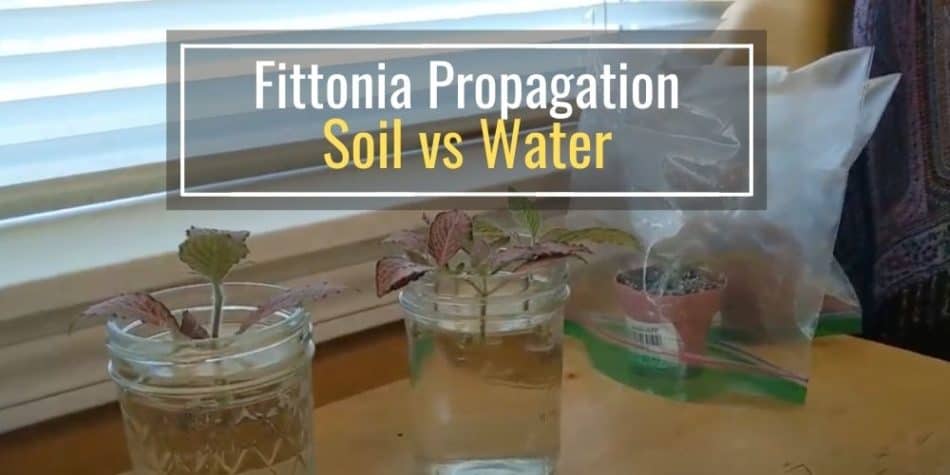Fittonias (nerve plants) are beautiful house plants that typically have green leaves with contrasting colors. As beautiful as these plants are, they can start to get leggy or awkwardly tall as they grow.
Thankfully fittonia plants can be trimmed and pruned in a manner so that they remain bushy. But this made me wonder what we should do with the cuttings. After all, cuttings can usually be used to propagate or start new plants.
I ran an experiment and propagated fittonia cuttings in a jar of water and a pot of soil. The results of the experiment are below but here’s the summary of what I found.
Fittonias (Nerve Plants) will propagate in both water and soil. Take cuttings from the plant, trim the leaves near the base of the cuttings, and either place in a jar of water or in a pot of soil. The cuttings will grow roots out of the leaf nodes that were trimmed. Transfer the cuttings to its long term location once the roots have reached 1 inch in length.
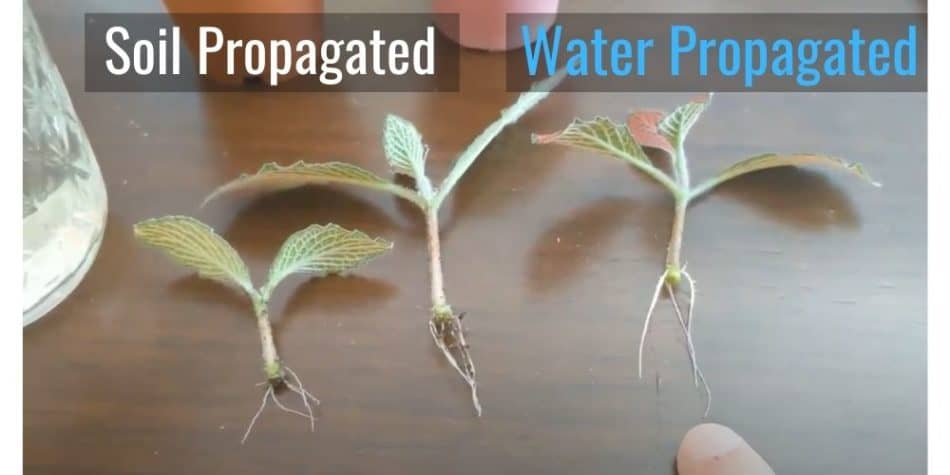
Before propagating the fittonia plant make sure to flip through this comprehensive Fittonia Care Guide in order to ensure that the fittonia plant is as healthy as possible.
Here’s a video on pruning and propagating fittonias:
How To Prepare Fittonia Cutting For Propagation
After pruning or trimming the fittonia plant, there will be cuttings leftover. Ideally the cuttings should be as tall as possible so if you want to remove a piece of the plant with 3 layers of leaves then trim it beneath that 3rd leaf layer.
Try to remove cuttings from the plant that have at least two layers of leaves in order to propagate it. If the cutting only has 1 layer of leaves (i.e. two leaves) then the cutting may not survive.
The bottom leaves of each cutting will be pruned in order to encourage roots to sprout from each cutting.
Below is an image of where I have a cutting with 3 layers of leaves (6 leaves total) and I prune the bottom two leaves.
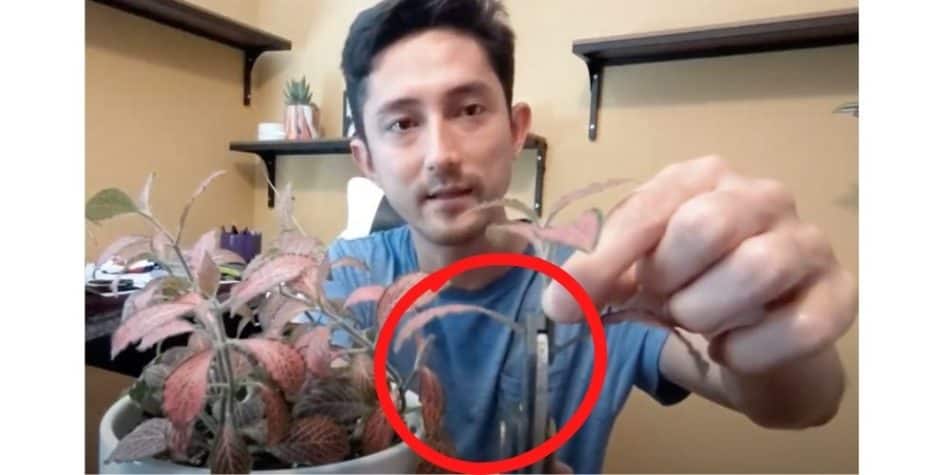
This leaves nodes near the base of this cutting is where the roots will grow out of.
Propagating Fittonia Cuttings In Water (Hydroponics)
Propagating the cuttings in water is my preferred method since it’s the easiest to do and most interesting to see happen.
Hydroponics sounds scary to anyone that hasn’t attempted it but its quite simple. You are just growing the plant, or in this case encouraging root growth in your cuttings, by using just water instead of soil.
Here is what you will need in order to propagate cuttings in water:
- A water container such as a mason jar
- Water (I used regular tap water with 100% success)
- Sunny location or grow light
The cuttings just need to be placed in the water container. The cutting bottom or base needs to be submerged in the water while the leaves need to stay dry above the water.
You can either use the leaves to support the cutting out of the water by placing the leaves on the container’s rim. Or use string or a mesh lid to keep the cutting’s leaves out of the water.
After about 1 month of the cuttings growing in the water, they should have healthy root growth as seen in the photo below:
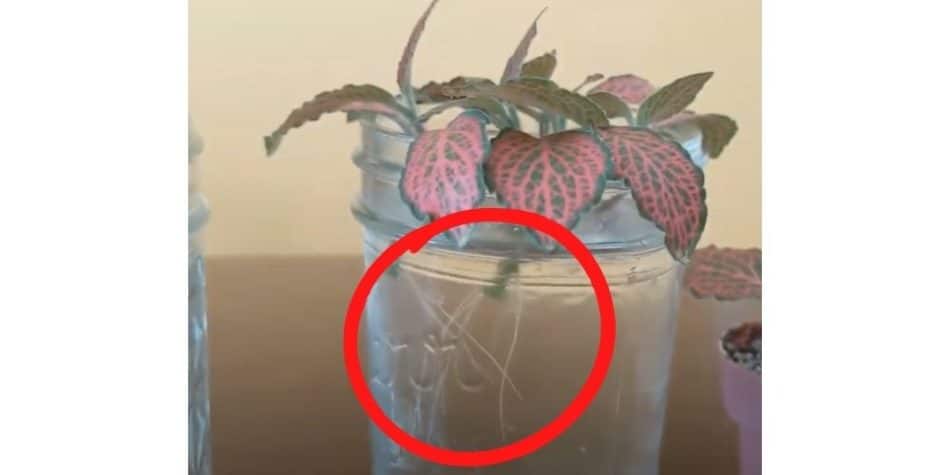
Once the roots are at least 1 inch in length then the cuttings are ready to be transplanted.
Propagating Fittonia Cuttings In Soil
Propagating the cuttings in soil is a more common method for starting new plants. The most important step when starting new cuttings in soil is keeping the soil moist the entire time.
Cuttings and seeds will not grow roots in dry soil so it’s critical to maintain moist soil for root growth.
Here is what you will need in order to propagate cuttings in soil:
- A pot with indoor soil
- Humidity dome or plastic bag to help retain moisture
- Sunny location or grow light
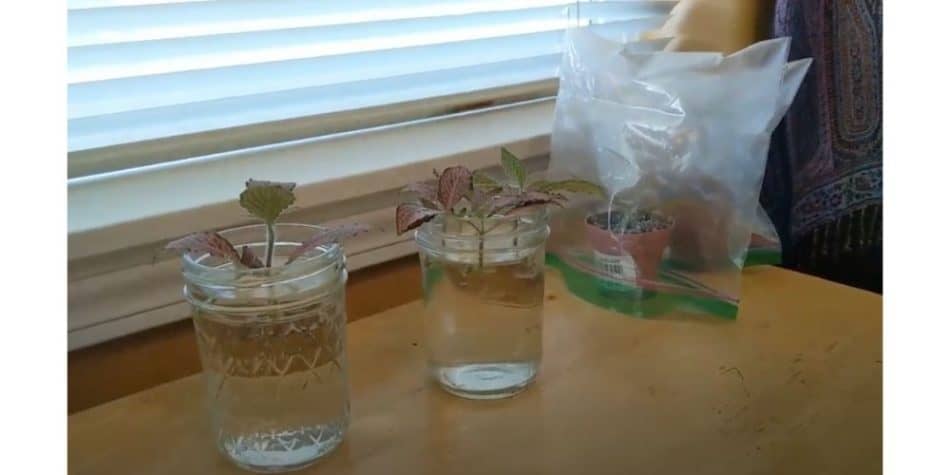
Germinating seeds in soil or propagating plants in soil benefit greatly from the use of a humidity dome. The purpose of the humidity dome is to keep the moisture high near the plant and in the soil.
Cuttings can still be propagated in soil without a humidity dome although you need to closely monitor the moisture in the soil. Stick your index finger into the soil about 1 inch to feel how moist the soil still is. This is about how deep the roots are so they need to be in damp soil.
Transferring Cuttings Into Soil
Whether the cuttings have sprouted roots from water or soil, transplanting the cuttings into soil have the exact same steps.
Quick note: Fittonia cuttings, and most plant cuttings, can continue to grow in hydroponics (i.e. water) but will require nutrient water after the roots have developed. Tap water or any water does not have macronutrients (N-P-K) or micronutrients that the plants need to continue to grow.
Here are the steps to transplant a cutting into soil:
- Remove the cutting from the water container or pot
- Use your index finger to poke a small hole into the soil about 1 inch deep
- Gently place the roots into the hole and gently fill the hole with soil
- Ensure that the cutting stands upright after the hole is filled
Here is how my fittonia pot looks with both the hydroponic and soil cuttings transplanted:
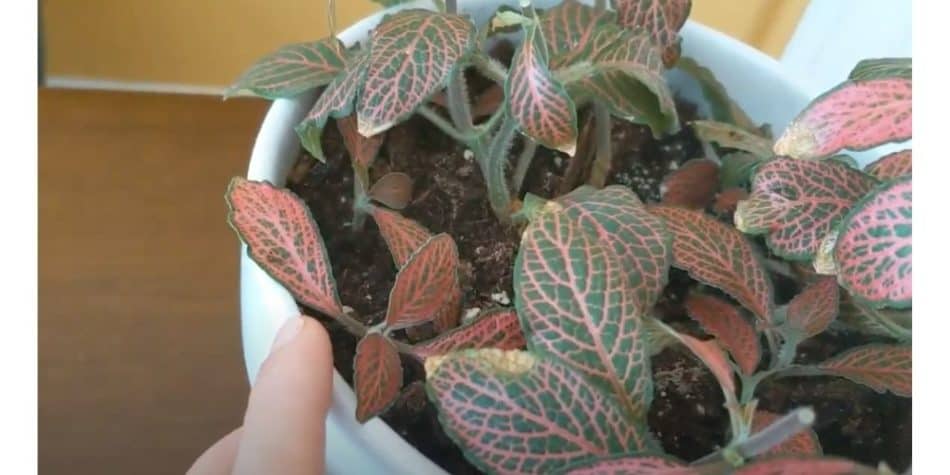
Frequently Asked Questions
Q: Can You Propagate Nerve Plants?
A: Nerve plants (Fittonias) can be propagated from trimmings. Simply trim a branch of the nerve plant that has at least 2 leaf nodes. Cut the bottom leaves off so that new roots can grow out of the trimmed leaf nodes. Nerve plants can propagate in soil or in water (hydroponics).
Q: Will Fittonia (Nerve Plants) Root In Water?
A: Fittonias (Nerve Plants) can root in water. As long as the bottom leaf nodes are trimmed and are submerged in water then the plant will sprout new roots. Fittonias will sprout 1 inch roots in water after about 1 month so make sure the base of the cutting or plant stays submerged in water.
Q: Can A Nerve Plant Grow In Water?
A: Nerve plants can grow in water (hydroponics). However, the plant will need nutrients if the fittonia is to grow in water for longer than a month. See this article to understand how hydroponic gardening works and how to feed plants grown in water.
Final Thoughts
Fittonias (nerve plants) are great household plants that just need a little bit of maintenance to prevent them from getting too leggy.
The best solution is to prune or trim the fittonia plant and use the cuttings to start new fittonia plants. These cuttings can be replanted in the original fittonia plant to help thicken the plant.
Whether you decide to replant the cuttings with the original plant or gift your friends and family with new fittonia plants – there are two great ways to propagate your cuttings.

